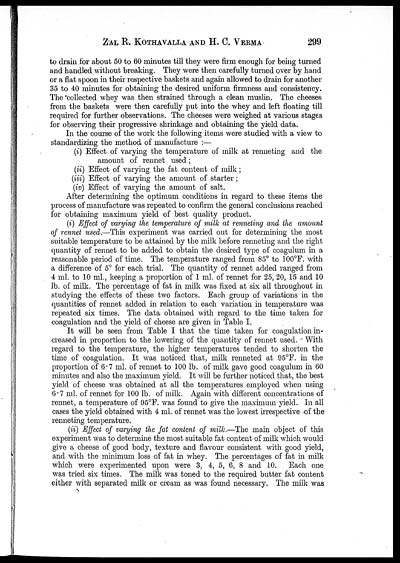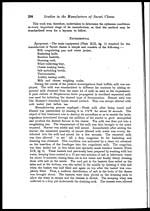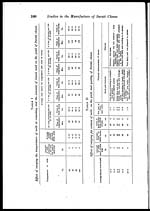Medicine - Veterinary > Veterinary colleges and laboratories > Indian journal of veterinary science and animal husbandry > Volume 12, 1942 > Original articles > Studies in the manufacture of Surati cheese
(335) Page 299
Download files
Individual page:
Thumbnail gallery: Grid view | List view

ZAL R. KOTHAVALLA AND H. C. VERMA 299
to drain for about 50 to 60 minutes till they were firm enough for being turned
and handled without breaking. They were then carefully turned over by hand
or a flat spoon in their respective baskets and again allowed to drain for another
35 to 40 minutes for obtaining the desired uniform firmness and consistency.
The collected whey was then strained through a clean muslin. The cheeses
from the baskets were then carefully put into the whey and left floating till
required for further observations. The cheeses were weighed at various stages
for observing their progressive shrinkage and obtaining the yield data.
In the course of the work the following items were studied with a view to
standardizing the method of manufacture :—
(i) Effect of varying the temperature of milk at renneting and the
amount of rennet used;
(ii) Effect of varying the fat content of milk;
(iii) Effect of varying the amount of starter;
(iv) Effect of varying the amount of salt.
After determining the optimum conditions in regard to these items the
process of manufacture was repeated to confirm the general conclusions reached
for obtaining maximum yield of best quality product.
(i) Effect of varying the temperature of milk at renneting and the amount
of rennet used.—This experiment was carried out for determining the most
suitable temperature to be attained by the milk before renneting and the right
quantity of rennet to be added to obtain the desired type of coagulum in a
reasonable period of time. The temperature ranged from 85° to 100°F. with
a difference of 5° for each trial. The quantity of rennet added ranged from
4 ml. to 10 ml., keeping a proportion of 1 ml. of rennet for 25, 20, 15 and 10
lb. of milk. The percentage of fat in milk was fixed at six all throughout in
studying the effects of these two factors. Each group of variations in the
quantities of rennet added in relation to each variation in temperature was
repeated six times. The data obtained with regard to the time taken for
coagulation and the yield of cheese are given in Table I.
It will be seen from Table I that the time taken for coagulation in-
creased in proportion to the lowering of the quantity of rennet used. With
regard to the temperature, the higher temperatures tended to shorten the
time of coagulation. It was noticed that, milk renneted at 95°F. in the
proportion of 6.7 ml. of rennet to 100 lb. of milk gave good coagulum in 60
minutes and also the maximum yield. It will be further noticed that, the best
yield of cheese was obtained at all the temperatures employed when using
6.7 ml. of rennet for 100 lb. of milk. Again with different concentrations of
rennet, a temperature of 95°F. was found to give the maximum yield. In all
cases the yield obtained with 4 ml. of rennet was the lowest irrespective of the
renneting temperature.
(ii) Effect of varying the fat content of milk.—The main object of this
experiment was to determine the most suitable fat content of milk which would
give a cheese of good body, texture and flavour consistent with good yield,
and with the minimum loss of fat in whey. The percentages of fat in milk
which were experimented upon were 3, 4, 5, 6, 8 and 10. Each one
was tried six times. The milk was toned to the required butter fat content
either with separated milk or cream as was found necessary. The milk was
Set display mode to: Large image | Zoom image | Transcription
Images and transcriptions on this page, including medium image downloads, may be used under the Creative Commons Attribution 4.0 International Licence unless otherwise stated. ![]()
| Permanent URL | https://digital.nls.uk/75322262 |
|---|
| Description | Covers articles from 1942. |
|---|




